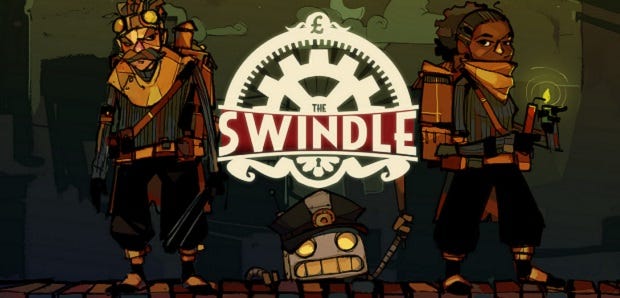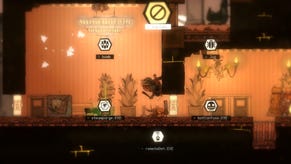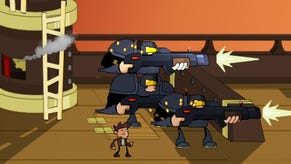Wot I Think: The Swindle
Dwindling Returns
Steampunk London-town heist caper The Swindle [official site] should feel comfortable in the shadows. It's a sneak 'em up, with gadgets, set in self-contained randomised levels full of robotic guards, fatal falls and explosive traps. There are also clanking great computers that a skilled hacker can siphon cash out of and piles of cash. All of these elements are scattered willy-nilly around the interiors of the various slums, factories and warehouses you'll guide your endless supply of miscreants through. Here's wot I think.
The Swindle isn't the kind of stealth game that particularly cares how much of a racket you make as you're smashing windows and triggering mines. Guards have clearly marked sightlines, whether that be a couple of blocks in front of them or a swinging spotlight cast down from above. There are various types of guard, as well as policebots who arrive on the scene if the alarm is triggered, and each variety has specific behaviours, easy to learn and exploit.
Like Mark of the Ninja, The Swindle is a stealth game that provides all the information that you need to stay hidden up-front. The rules of each level are painted on top of it, in those lines of sight and even in the tile-based structure of the buildings. It's possible to fail due to poor reactions or a botched walljump but most of the time you'll fail because you get greedy and try to push yourself just a little too far.
The risk-reward loop is effective and the tools for challenging infiltrations and robbery are all in place, but The Swindle is undone by the structure of its campaign. The basic idea is similar to Klei's Invisible, Inc. A countdown has started when the game begins, and you can undertake a limited number of missions before heading to the final showdown with whatever resources you've managed to grab along the way. It's a bit like the journey to the Crystal Dome, right down to the hilarious sight of people grabbing a fistful of tokens that end up being worthless. In the Dome that was because the tokens were the wrong colour – in The Swindle, it's because they end up in a heap next to your burglar's corpse.
Your little avatars will die a lot. They have splendid names, as do the streets and building you'll be infiltrating, and the portrayal of a ramshackle steampunk London is wonderful, thanks to the work of artist Michael Firman and composer Tobey Evans. Every machine looks as if it's caught between madcap efficiency and total collapse, and the change in the music as the siren-topped copbots close in is perfect.
There is time enough for one hundred heists before the final encounter and every dead robber, ever failed attempt, leaves you with no extra cash in your stash. You're trying to grab as much money as possible on each outing while also making it back to your airship pod in one piece. Gather naught but a few quid and you might as well have skipped the mission entirely but hacking your way to a grand is pointless if you end up dead at the bottom of a chute, with the money blanketing your corpse.
The 100-crime structure leads to a great deal of repetition. Every building is new, sure enough, but they're all a combination of pieces plugged together and you'll quickly recognise patterns. The first time I fell through a window, planning to follow the corridors underneath the main patrol route in some dingy hovel, I thought I was being smart. The tenth, fifteenth and twentieth time I did something similar, I was going through the motions. To survive the in-built repetition loop, The Swindle would need far more possibilities for emergent behaviour (of both items and entities) within its small spaces. As it is, there aren't enough combinations to allow for the kind of improvised escapades that make playing Spelunky such a joy.
To make things worse, most of the interesting possibilities are hidden behind a system of unlocks. The Swindle doesn't use skills and gadgets to provide new ways to approach problems – some problems are simply impassable until you have collected enough cash to unlock the correct solution. At its simplest, that means you'll be unable to reach certain rooms until you've bought the double jump (which is then available to all of your burglars, no matter how many die) and unable to collect cash from computers until you've bought the hacking skill. Because of that, The Swindle feels more like a Metroidvania hunt for keys/powers than a Spelunky-like playground that contains more and more toys. Unlike a Metroidvania game there are no connections between levels, which are themselves jumbled fragments rather than cohesive places, and I found the combination of limited powers and impassable obstacles frustrating and tedious in the early stages.
The game does improve as you unlock abilities, particularly when the action moves to new areas. As explosive blimps and traps are introduced, there's more room for chain reactions of unexpected cause and effect, as well as opportunities to trick enemies into assisting you in your crimes. There's never quite enough happening though and by the end of my first successful run, I felt as if I'd seen everything the game had to offer.
There are opportunities to tweak your path through the unlocks, supporting your chosen playstyle whether it be rough and tumble, or ghostly silent. I think I was happiest when I took a cudgel to every robot in sight and scrambled through the levels, sneaking be damned. None of the abilities nor the composition of the levels ever excited me – I felt like I was playing a heisty adaptation of Spelunky, a slow and steady Spelunky-like, that had failed to capture any of the accidental farce or skillful improv that makes Spelunky such a delight to play, even years after release. In that sense, the graphics, music and overall style of the game almost become a detriment – they're working so hard to convey a sense of fanciful fleet-fingered folly that the game itself almost entirely struggles to keep up with.
Starting anew means persevering through the first burglaries, when your skillset is as limited as the options available to you. By the time brainbots are showing up and you've earned the right to blow holes in the level, you're likely to see a few scenes in which all of the tools brought into The Swindle align. Those sweet spots are surrounded by building after building of uneven challenges and unhappy coincidence that will give you newfound respect for the carefully controlled and curated procedural generation of Spelunky and Invisible, Inc., The Swindle's closest recent bedfellows.
Right at the top, I said that The Swindle should feel comfortable in the shadows. Its design, both in the short-term of each level and the long-term of the countdown structure, places it in the shadow of two games that it can't comfortably live with or escape. Even judged in isolation, however, The Swindle is a minor diversion at best, without the comic timing or cunning to turn anyone to a life of crime. A weekend of crime, perhaps, at most.
The Swindle is available now.




















